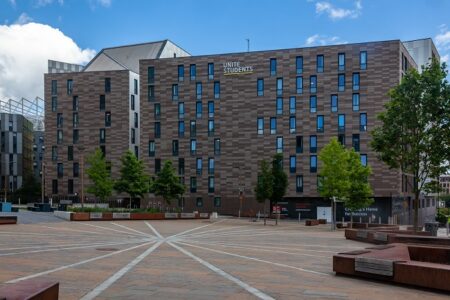Heating halls: How universities can offer safe and sustainable student housing
Oliver Baker, chief executive of Ambion Heating, speaks to Education Property about how low-carbon heating is the key to providing affordable, safe, and sustainable accommodation for students

Oliver Baker
Student housing has evolved significantly over the past 50 years, from basic living quarters converted from office blocks and hotels to small-scale villages with amenities tailored specifically for the needs of those attending university.
According to Knight Frank’s Student Property Report, an additional 263,000 full-time undergraduates are expected to begin higher education between now and 2030.
And, for many, it will be their first experience living away from home and their expectations of what their new homes will be like include being clean, modern, and comfortable.
Unfortunately, the reality experienced by attending students is quite different.
Falling short
Despite a recent shift towards more-modern and purpose-built student accommodation (PBSA), some students have found properties fall short of their wish list.
Two of the biggest problems reported in the latest National Student Accommodation Survey were dampness and a lack of heating.
The report found that over 33% of those surveyed have had issues with damp, and 29% experienced a lack of heating or water.
Damp within a property is problematic as it can often lead to mould, which can have negative health effects including respiratory eye and/or skin irritation.
Not only are some properties not providing graduates with safe accommodation, but they’re often unaffordable, as 64% of those paying rent said they struggle with the cost at least some of the time.
In the UK, students’ most-common accommodation types are privately rented, university halls of residence, private sector halls of residence, or living at home.
Students living at home usually don’t have to worry about what their new lodgings might be like, but for the other 1.2 million students living away, finding an affordable and safe property can be problematic.

More than 1.2 million students live in rented accommodation or halls of residence, and many face rising heating costs and problems with damp and mould
Managing rising costs
The National Student Accommodation Survey found that many students have bills included in rent – especially those living in halls, with 56% of students saying they have energy bills included.
This can be a great way for students to avoid the fluctuating costs many households are facing with their energy bills.
Where energy bills are not included in the rent, some students, already struggling to afford accommodation costs may not turn on their heating, leading to the issues with a lack of heating, as well as problems with dampness and mould being exacerbated.
Unfortunately, given the persistently-high energy prices, there is a significant challenge for property owners who cover energy costs to satisfy the expectations of students and educational institutions and ensure a profitable return on their investments.
And this could become a risk to bills being included in the future, or mean a rise in rental prices to cover costs.
Whether in new-build or retrofit properties, fulfilling existing and forthcoming accommodation requirements set out by the university, local authorities, and the Government may require capital investment to improve building fabric or add solar PV or new low-carbon heating systems.
This can be difficult in today’s current climate, where prices across the supply chain have increased significantly over the past few years.
However, property owners mustn’t give up on their responsibilities to provide affordable and safe housing for today’s and tomorrow’s students.
Meeting net zero targets
Ensuring properties have the necessary energy efficiency measures and affordable heating systems while balancing upfront costs can be hard to achieve for many education providers, student housing developers and landlords, especially as there is a third element to consider.
Housing providers also need to assess their environmental impact, more specifically how their property portfolio will meet net zero targets over the coming years.
As owners of large estate portfolios, the UK’s higher education institutions are uniquely positioned to take the lead in decarbonisation efforts to meet the country’s net zero targets.
Consequently, they are facing increasing pressure from funders, staff, and prospective students to be more sustainable.
Heating, once again, is at the centre of the challenge.
When it comes to old housing stock, the question posed is how to replace often-decades-old systems with affordable low-carbon technology.
For PBSAs, it’s how to best manage costs and the need to implement low-carbon heating that is futureproofed against the ever-changing energy landscape.
Conventional electric heating systems don’t address the high cost of energy given their energy performance, while convection systems – including heat pumps – are not as effective in combating the problem of mould and damp.
Heat pumps can also be problematic because of their high upfront costs, and their size means they can be difficult to accommodate in the smaller units inherent in student accommodation.
Meeting all expectations can be arduous and sometimes unrealistic, but housing providers must find a way to supply students with affordable, safe and sustainable housing.
So, what is the solution to this trilemma?

Infrared heat systems deliver significant benefits, helping to lower energy consumption and costs and reducing a property’s environmental impact
Heating smaller properties
With the Government’s net zero plans focusing on electrification for heat, many property owners are turning to heat pumps.
However, this technology is often unsuitable for smaller houses and multi-occupancy buildings.
With a high upfront cost and a lengthy, complicated, and often-disruptive installation process, these systems require space that is often not available in halls of residence.
Requiring pipework, radiators, and external condenser units, heat pumps can also be costly to service and maintain, adding financial pressure to already-tight budgets.
In addition, convection systems, including heat pumps, don’t help combat the mould and damp that some student properties are prone to.
In fact, the warm air they produce, when coming into contact with cold walls, encourages condensation and mould, potentially harming residents’ wellbeing.
With traditional systems failing to ensure adequate and efficient heating, and options like heat pumps considered unsuitable or impractical for many accommodation types, many housing providers are turning to infrared heat panels as a solution.
Low carbon and low cost
Infrared heat works like the sun, giving the same feeling of direct warmth, but without any of the harmful rays.
It works by the fabric of the building and the materials within a room absorbing and storing the infrared waves, rather than the system heating the air and space – a much-more-efficient approach to heat.
Infrared can turn the property into a heat store, with significant benefits when used with the correct control system.
For example, Ambion Heating provides the only control system specifically designed for infrared, and importantly it is not based on a thermostat.
The unique control system uses constant dynamic pulsing, rather than a ‘zoning’ on/off approach used by other systems, to dramatically reduce energy usage and maintain a room’s temperature within 0.1C of its target, 24 hours a day.
The system works best by constantly pulsing across a flat demand profile, with no morning or evening energy spikes in usage.
With this method, the system can achieve around 25% savings in the unit cost of energy using a flexi tariff.
The results of using dynamic pulsing, plus the infrared panels, are significant, as users can expect to use up to 60% less electricity when compared to conventional systems.
Low-carbon heat panels can also reduce carbon emissions by up to 60% in flats or studios when compared with conventional heating systems.
They are also fully futureproofed to partner with solar and battery solutions for a complete net-zero approach.
This heating solution can not only help lower energy consumption, and therefore costs, but also reduce a property’s environmental impact.
A further benefit of low-carbon heat panels use is they can be fitted in a new purpose-built building or retrofitted to replace an existing gas or electric heating system using the electrical mains wiring.
Living in a warm and safe environment is critical to our health and wellbeing, something higher education institutions are committed to supporting their students with.
And, despite some accommodation issues, there’s an incredible opportunity to address these challenges and intelligently futureproof the student housing sector, bringing affordable, sustainable, and safe homes to residents.
